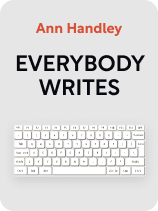

This article is an excerpt from the Shortform book guide to "Everybody Writes" by Ann Handley. Shortform has the world's best summaries and analyses of books you should be reading.
Like this article? Sign up for a free trial here.
Do you write emails or social media posts? What about business letters or marketing copy? How might your writing be improved?
In Everybody Writes, Ann Handley discusses what makes writing good and how to make your writing more valuable. She explains brand voice and how it can be adapted for various purposes. She also shares her writing process that’s useful for all types of writing.
Continue reading for an overview of this practical book.
Everybody Writes by Ann Handley
All of us have to write, whether it be for work, school, or communication. Fortunately, writing is more of a skill than a talent, and we can implement techniques to improve our writing in any format. In Everybody Writes, Ann Handley offers a comprehensive guide to writing everything you need to write in today’s business world. The book’s main focus is on writing for marketing purposes, but many of the principles can be applied to other types of writing as well.
Ann Handley is a bestselling author, speaker, and digital marketer. Alongside fellow writer and marketing consultant C.C. Chapman, Handley has co-authored another book about content creation and marketing, Content Rules. Everybody Writes was originally published in 2014, and this revised and expanded edition was published in 2022.
We’ll discuss what makes for high-quality writing, exploring how to make your writing useful, creative, and reader-centric. We’ll also look at how to create a brand voice and adapt it to different formats. Finally, we’ll look in-depth at Handley’s recommended process for writing the best content for every situation.
What Makes Good Writing?
Handley says that great writing comes from the following three ingredients: its usefulness to your audience, its foundation in creativity or data, and its connection with your audience.
Usefulness to Your Audience
Handley points out that your writing must help your reader in some way. Your content should be clear and specific, and it should let your audience know what problem of theirs you’re going to solve.
Before you start writing, establish the purpose of what you’re writing by identifying 1) what you’re trying to accomplish, 2) what the main idea is, and 3) why it matters to your audience (also known as the “so what?” factor).
Grounding in Creativity and Data
In addition to being useful to your reader, your writing should be creative and factually accurate.
According to Handley, writing that’s creative stands out more to the reader. To evoke emotions, write so that your reader can see themselves reflected in your content. Handley particularly recommends using stories in your writing.
Handley cautions, though, that the persuasiveness of stories doesn’t mean you should neglect rationality in your writing: Your writing also needs to be based on facts and accurate data to reach your audience. Handley points out that a brand’s writing presents them with a great opportunity to build credibility and trust with customers.
Connection With Your Audience
Your writing must feel like it’s written by a human who relates to and understands the audience. Handley explains that the best way to connect with your audience is to make your reader or customer the protagonist of your story. Advocate for your audience and write to their needs. To do this, find out what your audience needs and wants, what’s important to them, and why they do what they do.
How to Develop Brand Voice
A strong brand voice offers an identity for the customer to align with, and it can be the deciding factor when customers are choosing between you and your competitors.
Handley says you’ll first need to identify what type of voice your brand needs. Consider how formal you want to sound and how much emotion and humor you want to infuse. Come up with a few adjectives, and then flesh them out into elaborative sentences.
Once you’ve determined your ideal voice, create a style guide—a written compilation of the rules and principles for maintaining your brand voice—for your brand.
Tools for Establishing Voice
If you choose to add humor to your voice, it should be relatable and reveal a common interest your audience shares with your brand, which can build loyalty. Another way to use your voice is to create strong and relatable analogies. Analogies can help clarify or explain ideas, make your writing more memorable, and convey a lot about your brand.
How to Adapt Your Writing to Different Formats
The book’s ideas are mainly focused on business and marketing writing, but this is still a very broad category. Handley emphasizes that the content you create will vary depending on the format and your intention as a writer. In all of these types of writing, Handley recommends keeping your brand voice consistent. However, your tone may need to shift to match what you’re writing.
Social Media
The point of social media is connection, so you’ll want to take on a tone that’s inviting and friendly.
Video
Rules of grammar are far less important, Handley says, as your customers won’t be reading your writing but hearing it out loud. In writing a script for a video, story becomes even more important and useful, and you should rely heavily on visuals to communicate that story. Also, write your script as it’s going to be read.
Commenting on Social Causes
According to Handley, research suggests that consumers respond well to brands that take a stand on social issues. However, you should always approach these topics with awareness and sensitivity.
How to Write
Handley frequently reiterates that there is no single correct way to create content, but she offers tips and processes to help you get started and, more importantly, get into the habit of writing.
Make Writing a Habit
Handley first recommends that you make writing a daily practice. The key to improving your writing is to do more of it. Handley recommends a strict daily writing routine and says that missing days lessens your motivation to write. She recommends practicing writing in whatever form works best for you.
Handley also advises that you identify what time of day your writing is the strongest and write at that time every day. She also suggests slowing your writing down by using pen and paper.
Draft 1
Handley describes a writing process that begins with identifying what format you want to write in, what purpose it will serve for the audience, and what structure will best fit your piece. Next, gather any information from outside sources that you may need, and be sure to cite them when you write. In selecting sources to use, try to find primary sources instead of secondary.
Additionally, try to find recent sources for facts and data, as information can change rapidly, and you don’t want to misrepresent any facts in your piece. Keep track of your sources as you go, and create formal citations as needed.
Next, draft your piece—Handley recommends writing four drafts. The first is your rough draft, which she emphasizes will not look good. This draft is just about getting your ideas on the page. Once finished, she recommends stepping away from this draft for a while.
Draft 2: Editing
Once you’ve written a first draft, the next step is to begin editing it. There are different types of editing, including what Handley calls developmental editing, or editing on a larger scale, and line editing, or detailed editing. The editing process includes applying writing “rules” to your piece, but Handley emphasizes that the rules are secondary to your purpose and that you can always break the rules if it suits your piece.
Large-scale editing involves confirming that you’re conveying your main idea and purpose clearly and logically and that your piece has a strong lead-in to grab the reader’s attention. Cut anything extraneous, and identify anything that’s been left out.
Detailed editing involves making sure that every word conveys something important and cutting words that don’t. Handley recommends being particularly wary of fluff words like “very.”
Language Rules
Handley specifies that the rules you learned in school don’t necessarily apply to writing as a brand. Here are some specific guidelines she advises you to consider:
- Use active voice over passive voice.
- Avoid buzzwords like “innovative” and “synergy.”
- Avoid excessive jargon.
- Write in the present tense and second person.
- Make every word count.
Draft 3
Draft 3 is when you’ll focus on your connection to the audience. Handley recommends imagining one specific individual as your reader and switching perspectives with them.
Draft 4
Finally, draft 4 is when you’ll add style and voice to your piece. This includes things like humor and figurative language. Here, Handley emphasizes that you should write in second person. She also suggests using things like bullet points to make the piece more visually appealing.
The Final Edit
Once your fourth draft is finished, it’s time to ask others to help with your editing. Before publication, Handley also recommends that you read your final draft out loud. Then, review it visually.
Finally, once your work has been published, let your attachment to it go. After it’s published, your work doesn’t belong to you anymore: It belongs to the public. If you have regrets about the final product because it wasn’t quite what you wanted it to be, take it as a lesson for next time. And finally, congratulate yourself! You’ve just accomplished something great.

———End of Preview———
Like what you just read? Read the rest of the world's best book summary and analysis of Ann Handley's "Everybody Writes" at Shortform.
Here's what you'll find in our full Everybody Writes summary:
- Why there is no such thing as a bad writer
- A guide to improving your writing and reaching your audience
- How to adapt your writing to different formats while maintaining your voice







I learn more from this, and being a better and good writer is my dream.